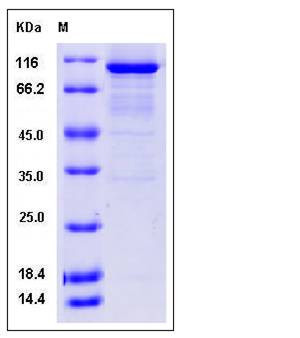Human DCAMKL1 / DCLK1 Protein (aa 1-705, His & GST Tag)
CL1,CLICK1,DCAMKL1,DCDC3A,DCLK
- 100ug (NPP2073) Please inquiry
| Catalog Number | P11588-H20B |
|---|---|
| Organism Species | Human |
| Host | Baculovirus-Insect Cells |
| Synonyms | CL1,CLICK1,DCAMKL1,DCDC3A,DCLK |
| Molecular Weight | The recombinant human DCLK1/GST chimera consists of 942 amino acids and has a calculated molecular mass of 106 KDa. It migrates as an approximately 105 KDa band as predicted in SDS-PAGE under reducing conditions. |
| predicted N | Met |
| SDS-PAGE |  |
| Purity | > 84 % as determined by SDS-PAGE |
| Protein Construction | A DNA sequence encoding the human DCLK1 (O15075-1) (Met 1-Val 705) was fused with the N-terminal polyhistidine-tagged GST tag at the N-terminus. |
| Bio-activity | The specific activity was determined to be 6.1 nmol/min/mg using synthetic Autocamtide-2 peptide (KKALRRQETVDAL-amide) as substrate. |
| Research Area | Immunology |Signal Transduction |Protein Kinase |Intracellular Kinase |Ca2+/Calmodulin-Dependent Protein Kinase (CaM Kinase) |
| Formulation | Supplied as sterile 20mM Tris, 500mM NaCl, pH 7.4, 10% gly, 0.5mM PMSF 1. Normally 5 % - 8 % trehalose, mannitol and 0.01% Tween80 are added as protectants before lyophilization. Specific concentrations are included in the hardcopy of COA. |
| Background | DCAMKL1, also known as DCLK1, is a member of the protein kinase superfamily and the doublecortin family. It contains two N-terminal doublecortin domains, which bind microtubules and regulate microtubule polymerization, a C-terminal serine/threonine protein kinase domain, which shows substantial homology to Ca2+/calmodulin-dependent protein kinase, and a serine/proline-rich domain in between the doublecortin and the protein kinase domains, which mediates multiple protein-protein interactions. DCAMKL1 is involved in several different cellular processes, including neuronal migration, retrograde transport, neuronal apoptosis and neurogenesis. Its microtubule-polymerizing activity is independent of its protein kinase activity. DCAMKL1 may be involved in a calcium-signaling pathway controlling neuronal migration in the developing brain. It may also participate in functions of the mature nervous system. |
| Reference |
